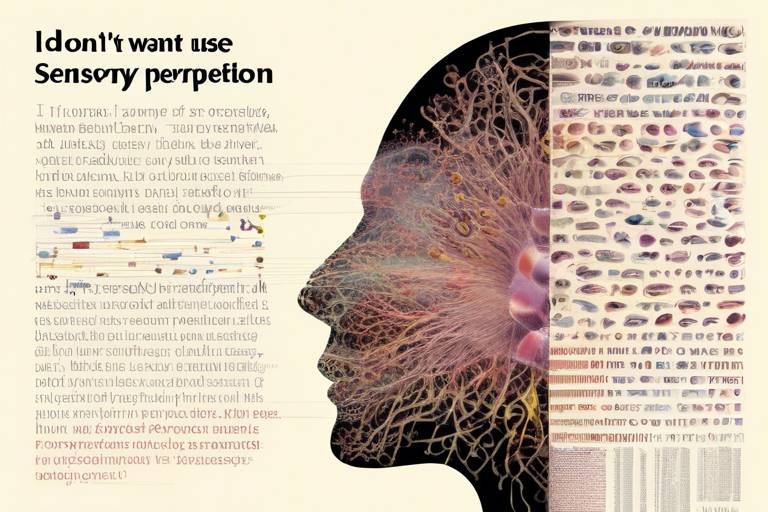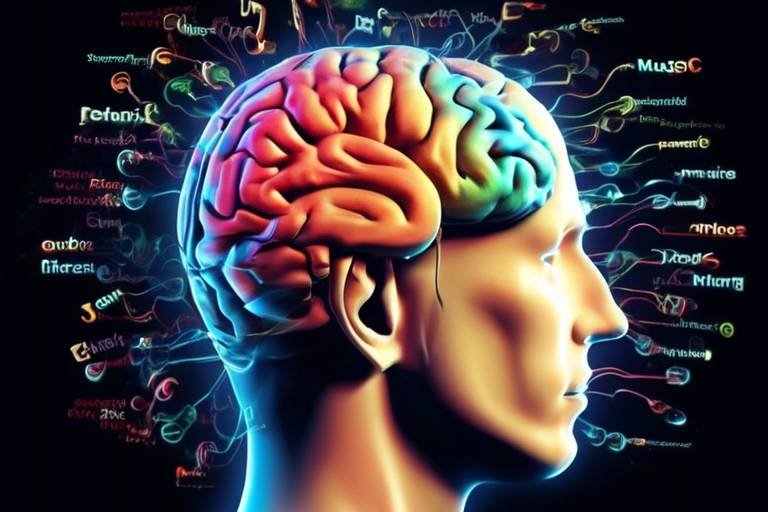The Biology of Exercise - Benefits for Body and Mind
Exercise is often touted as a miracle remedy for both physical and mental health, but what lies behind this claim? When we engage in physical activity, our bodies undergo a myriad of changes that not only enhance our physical fitness but also contribute significantly to our mental well-being. Imagine your body as a finely tuned machine; when you add the right fuel and perform regular maintenance—in this case, exercise—you unlock its full potential. This article explores the physiological and psychological advantages of exercise, delving into how physical activity enhances overall health, mood, and cognitive function.
Understanding how exercise impacts bodily functions, including cardiovascular health, muscle strength, and metabolism, reveals the profound benefits of regular physical activity on overall wellness. When you exercise, your heart pumps faster, improving blood circulation and oxygen delivery to your muscles. This process not only strengthens your heart but also enhances your lung capacity, making daily activities feel easier. Furthermore, engaging in strength training builds muscle mass, which is crucial for maintaining a healthy metabolism. As you burn more calories at rest, you create a favorable environment for weight management and overall health.
But it’s not just the body that reaps the rewards of exercise; the mind does too! Physical activity is a powerful tool for reducing stress, anxiety, and depression while simultaneously improving mood. Think of exercise as a natural antidote to life's pressures. When you break a sweat, your body releases a cocktail of chemicals that promote feelings of happiness and relaxation. This is why many people experience a sense of euphoria after a good workout, often referred to as the "runner's high." The beauty of this is that you don’t need to run marathons; even a brisk walk can do wonders for your mental state.
Exploring the role of neurotransmitters like endorphins and serotonin highlights how exercise influences mood and emotional well-being. Endorphins, often dubbed as the body's natural painkillers, are released during physical activity and can create a feeling of bliss. Meanwhile, serotonin, a neurotransmitter that regulates mood, is also boosted through regular exercise. This combination can significantly reduce feelings of anxiety and depression, making exercise a natural and effective form of therapy. So, the next time you're feeling down, consider lacing up your sneakers instead of reaching for a pill bottle!
Physical activity serves as a natural stress reliever, promoting relaxation and reducing cortisol levels in the body. Cortisol is often referred to as the "stress hormone," and elevated levels can lead to various health issues, including weight gain and sleep disturbances. Engaging in activities such as yoga, swimming, or even dancing can lower cortisol levels and help you unwind. Picture this: after a long day at work, a quick session of physical activity can transform your mood and help you leave your stress behind.
Here, we investigate the connection between exercise and enhanced cognitive abilities, including memory, focus, and overall brain health. Studies have shown that regular physical activity can lead to improved brain function and a reduced risk of cognitive decline as we age. This is largely due to increased blood flow to the brain, which nourishes brain cells and promotes the growth of new ones. Think of exercise as a workout for your brain, sharpening your focus and boosting your memory. It’s not just about lifting weights; it’s about lifting your mental capabilities too!
Regular physical activity contributes to maintaining a healthy weight, preventing obesity, and promoting metabolic health. When coupled with a balanced diet, exercise helps create a calorie deficit, which is essential for weight loss. Moreover, it helps to build lean muscle mass, which burns more calories at rest compared to fat. This means that the more muscle you have, the easier it becomes to maintain your weight. In essence, exercise is a key player in the game of weight management, making it a vital aspect of a healthy lifestyle.
Understanding the importance of exercise in the aging process highlights how physical activity can improve longevity and quality of life for older adults. As we age, maintaining our physical capabilities becomes increasingly important. Regular exercise helps combat the natural decline in muscle mass and strength, allowing older adults to remain active and independent.
Focusing on the significance of strength training, this part addresses how it helps preserve muscle mass and functionality as we age. Engaging in resistance training not only builds muscle but also strengthens bones, reducing the risk of fractures and osteoporosis. It’s like putting on armor that protects you as you grow older, allowing you to enjoy life without the fear of physical limitations.
This section emphasizes the importance of aerobic exercise in promoting heart health and enhancing endurance, crucial for an active lifestyle as we age. Activities like walking, cycling, and swimming not only boost heart health but also improve lung capacity and overall stamina. Imagine being able to keep up with your grandchildren or enjoy a leisurely hike without feeling winded. That’s the power of regular exercise!
- How often should I exercise? Aim for at least 150 minutes of moderate aerobic activity or 75 minutes of vigorous activity each week, along with strength training on two or more days.
- Can exercise help with anxiety? Yes! Regular physical activity can significantly reduce anxiety levels and improve overall mood.
- What types of exercise are best for older adults? Low-impact exercises like walking, swimming, and strength training are excellent choices for older adults.
- Is it too late to start exercising? It’s never too late! Starting at any age can bring about significant health benefits.

The Physiological Effects of Exercise
When it comes to understanding the benefits of exercise, it’s essential to dive deep into the physiological effects that physical activity has on our bodies. Exercise is more than just a means to shed a few pounds or tone your muscles; it’s a powerful catalyst for enhancing overall wellness. From boosting cardiovascular health to increasing muscle strength and metabolism, the effects of regular exercise are profound and far-reaching.
One of the most significant impacts of exercise is on cardiovascular health. Engaging in aerobic activities like running, cycling, or swimming strengthens the heart muscle, increases blood circulation, and improves the efficiency of the cardiovascular system. This means that your heart can pump more blood with less effort, which is crucial for overall health. In fact, studies have shown that regular exercise can reduce the risk of heart disease, stroke, and hypertension. It's like giving your heart a workout that prepares it for the challenges of everyday life!
But the benefits don’t stop there. Exercise also plays a vital role in enhancing muscle strength. When you engage in resistance training, whether it’s lifting weights or performing bodyweight exercises, you stimulate muscle fibers, leading to growth and increased strength. This is particularly important as we age. Maintaining muscle mass not only helps with mobility but also supports metabolic function. In essence, stronger muscles mean a more efficient metabolism, which can help in managing weight and preventing obesity.
Speaking of metabolism, regular physical activity is a game-changer for your metabolic rate. Exercise increases the number of calories your body burns at rest, which is a fantastic way to maintain a healthy weight. It’s akin to revving up your engine; the more you exercise, the more your body becomes a calorie-burning machine. This is why incorporating various forms of exercise into your routine—like high-intensity interval training (HIIT) or strength training—can be so effective for weight management.
Moreover, let's not overlook the impact of exercise on bone health. Weight-bearing exercises, such as jogging or dancing, stimulate bone formation and increase bone density. This is particularly crucial for older adults, as it helps in preventing osteoporosis and fractures. Think of your bones as a sturdy structure; the more you support them with physical activity, the stronger they become.
In summary, the physiological effects of exercise are multifaceted and incredibly beneficial. To encapsulate, here’s a quick overview:
| Benefit | Description |
|---|---|
| Cardiovascular Health | Strengthens the heart, improves circulation, and reduces the risk of heart disease. |
| Muscle Strength | Enhances muscle growth and functionality, vital for mobility and metabolism. |
| Metabolic Rate | Increases calorie burn at rest, aiding in weight management. |
| Bone Density | Supports bone formation and helps prevent osteoporosis. |
In conclusion, the physiological effects of exercise are not just about looking good; they are about feeling good and living a healthier, longer life. Whether you’re a seasoned athlete or just starting your fitness journey, embracing regular physical activity can transform your body in ways you never imagined. So, why not take that first step today? Your body will thank you!

The Psychological Benefits of Physical Activity
When we think about exercise, the first images that come to mind might be of toned bodies and sweat-drenched gym sessions. However, there's an entire universe of psychological benefits that often goes unnoticed. Engaging in regular physical activity does wonders for our mental health, transforming not just our bodies but our minds as well. Imagine exercise as a magic potion that can lift our spirits, sharpen our minds, and even help us cope with the stresses of daily life. Sounds intriguing, right?
One of the most significant impacts of exercise is its ability to reduce feelings of stress and anxiety. When we engage in physical activity, our bodies release a cocktail of neurotransmitters that play a crucial role in how we feel. These include endorphins, often dubbed the body's natural painkillers, which create a sense of euphoria commonly known as the "runner's high." This phenomenon is not just a myth; it's a real physiological response that can make you feel on top of the world.
But wait, there's more! Exercise also boosts the production of serotonin, a neurotransmitter that helps regulate mood. Low levels of serotonin are linked to feelings of depression and anxiety, so it's no wonder that people who engage in regular physical activity often report feeling happier and more balanced. It's like giving your brain a little tune-up, ensuring that everything runs smoothly. Think of it as an oil change for your mental engine!
To delve deeper into the science, let's explore how these neurotransmitters work. After a good workout, the brain releases not just endorphins but also dopamine and norepinephrine, which enhance mood and focus. This chain reaction can lead to improved emotional resilience, making it easier to tackle life's challenges. In fact, studies have shown that even moderate exercise can lead to significant reductions in symptoms of depression and anxiety.
Now, let's talk about stress. Life can throw curveballs that leave us feeling overwhelmed. This is where exercise shines as a natural stress reliever. Physical activity helps to lower levels of cortisol, the body's primary stress hormone. When we exercise, our bodies naturally shift into a more relaxed state, allowing us to unwind and recharge. It's like hitting the reset button on your mental state! So, the next time you're feeling frazzled, consider going for a brisk walk or hitting the gym instead of reaching for that pint of ice cream.
Moreover, the benefits of exercise extend to our cognitive functions. Ever noticed how a quick jog can clear your mind? That's because physical activity enhances blood flow to the brain, promoting the growth of new brain cells and improving overall brain health. Research indicates that regular exercise can lead to better memory, sharper focus, and improved problem-solving skills. It's not just about keeping fit; it's about keeping your mind fit as well!
In summary, the psychological benefits of physical activity are profound and far-reaching. From reducing stress and anxiety to enhancing mood and cognitive function, exercise is a powerful tool for improving mental health. So, whether you're lifting weights, dancing, or simply going for a walk, remember that every step you take is not just a step for your body but also a leap for your mind.
- How often should I exercise for mental health benefits? Aim for at least 150 minutes of moderate exercise each week to experience significant mental health benefits.
- Can any type of exercise improve my mood? Yes! Whether it's walking, running, yoga, or dancing, any form of physical activity can boost your mood.
- What if I don’t have time for a full workout? Short bursts of activity, even for 10-15 minutes, can still be beneficial for your mental health.

Have you ever wondered why a brisk walk can lift your spirits or why hitting the gym feels like an instant mood booster? The secret lies in our brain's chemistry, particularly in the role of neurotransmitters. These tiny chemical messengers are crucial in transmitting signals throughout the brain and body, influencing everything from our physical movements to our emotional states. Among the most notable neurotransmitters involved in mood regulation are endorphins, serotonin, and dopamine. Each plays a distinct role in how we feel and respond to the world around us.
When you engage in physical activity, your body releases endorphins, often referred to as the body's natural painkillers. This release can create a feeling of euphoria, commonly known as the "runner's high." It's like your body’s way of rewarding you for moving and exerting energy. These endorphins not only help to alleviate pain but also act as a powerful antidote to stress and anxiety. Imagine them as little warriors fighting off the negativity that life throws your way.
Then there's serotonin, another key player in mood regulation. This neurotransmitter is often dubbed the "happy chemical" because it contributes to feelings of well-being and happiness. Regular exercise has been shown to increase serotonin levels, leading to improved mood and a reduction in symptoms of depression. Think of serotonin as the sunshine that breaks through the clouds on a gloomy day; it brightens your outlook and makes the world seem a little more vibrant.
Dopamine, often associated with the brain's reward system, also plays a significant role in motivation and pleasure. When you exercise, dopamine levels rise, which not only enhances your mood but also encourages you to keep moving. It’s the same feeling you get when you check off tasks on your to-do list—each workout completed releases a little more dopamine, reinforcing the behavior and making it more likely you'll want to do it again. This cycle of reward can create a positive feedback loop, making exercise not just beneficial but something you look forward to.
To sum it up, the relationship between exercise and neurotransmitters is a fascinating one. When you move your body, you’re not just improving your physical health; you’re also giving your brain a boost. Here’s a quick overview of how these neurotransmitters influence your mood:
| Neurotransmitter | Function | Effect of Exercise |
|---|---|---|
| Endorphins | Pain relief and euphoria | Increased release during physical activity |
| Serotonin | Mood regulation and happiness | Boosted levels lead to improved mood |
| Dopamine | Motivation and pleasure | Enhanced release encourages continued exercise |
Understanding how these neurotransmitters work can help us appreciate the profound impact that exercise has on our mental health. It’s not just about building muscle or burning calories; it’s about creating a happier, healthier you. So, the next time you feel a little down, remember that a simple workout could be the key to lifting your spirits!
- How long should I exercise to feel the mood-boosting effects?
Even a short session of 20-30 minutes can elevate your mood significantly. - Can I experience these benefits from any type of exercise?
Absolutely! Whether it's running, dancing, or yoga, any physical activity can trigger the release of mood-enhancing neurotransmitters. - How often should I exercise for optimal mental health?
Most experts recommend at least 150 minutes of moderate aerobic activity each week, combined with strength training on two or more days.

In our fast-paced world, stress can feel like an unwelcome companion, lurking around every corner. But what if I told you that one of the most effective ways to combat stress is right at your fingertips? Yes, you guessed it—exercise! Engaging in physical activity is not just about building muscles or burning calories; it’s a powerful antidote to the pressures of daily life. When you exercise, your body releases a cocktail of hormones and neurotransmitters that work wonders for your mental health.
One of the key players in this stress-busting game is endorphins. Often dubbed the "feel-good" hormones, endorphins are released during physical activity and can create a sense of euphoria, often referred to as the "runner's high." This natural high can help to alleviate feelings of stress and anxiety, leaving you feeling more relaxed and at ease. Additionally, exercise increases the production of serotonin, another neurotransmitter that plays a crucial role in regulating mood. A boost in serotonin levels can lead to a significant improvement in your overall emotional well-being.
Moreover, exercise acts as a natural distraction from daily worries. When you’re focused on moving your body—whether it’s through a brisk walk, a dance class, or a challenging workout—you’re less likely to dwell on stressors. It’s a little like hitting the reset button on your mind. Think of it as a mini-vacation for your brain! This distraction can provide a much-needed break and help you return to your problems with a fresh perspective.
But the benefits of exercise don’t stop there. Regular physical activity can also help lower levels of cortisol, the body’s primary stress hormone. High cortisol levels can lead to a range of health issues, including anxiety, depression, and even physical ailments. By incorporating exercise into your routine, you can help keep cortisol levels in check, promoting a calmer, more balanced state of mind.
To put it simply, the relationship between exercise and stress reduction is a beautiful cycle: the more you move, the more you relieve stress, and the less stress you have, the more motivated you feel to keep moving. It’s a win-win situation! So, whether you’re hitting the gym, going for a run, or practicing yoga, remember that you’re doing more than just working out; you’re investing in your mental health.
So, how can you get started on this journey toward a stress-free life? Here are a few tips:
- Find an activity you enjoy: Whether it’s cycling, swimming, or dancing, choose something that makes you happy.
- Set realistic goals: Start small and gradually increase your activity level to avoid feeling overwhelmed.
- Make it a routine: Consistency is key, so try to incorporate exercise into your daily schedule.
In conclusion, exercise is a powerful tool for stress reduction that benefits both your body and mind. By making physical activity a regular part of your life, you can combat stress, enhance your mood, and improve your overall well-being. So, lace up those sneakers and get moving—your mind will thank you!
- How much exercise do I need to reduce stress?
Aim for at least 30 minutes of moderate exercise most days of the week to reap the stress-relieving benefits. - Can any type of exercise help with stress?
Yes! Whether it's cardio, strength training, or yoga, any form of physical activity can help reduce stress levels. - What if I don't have time to exercise?
Even short bursts of activity, like a 10-minute walk, can be beneficial. Every little bit counts!

When we think about exercise, our minds often drift to physical transformations—those toned abs or defined biceps. But what if I told you that exercise is like a magic potion for your brain? It's true! Engaging in regular physical activity doesn't just sculpt your body; it also enhances your cognitive abilities. In fact, studies have shown that exercise can lead to improved memory, sharper focus, and even a boost in creativity. Imagine your brain as a car engine; the more you rev it up with exercise, the more efficiently it runs.
So, how does this work? Well, when you exercise, your heart pumps more blood, which means more oxygen and nutrients are delivered to your brain. This increased blood flow is akin to pouring high-octane fuel into your vehicle, enhancing its performance. Moreover, physical activity stimulates the release of neurotransmitters—those tiny chemical messengers in your brain that play a crucial role in how we think and feel. For instance, exercise boosts levels of brain-derived neurotrophic factor (BDNF), a protein that fosters the growth of new neurons and synapses, which are essential for learning and memory.
Additionally, let’s not overlook the impact of exercise on stress and anxiety, two notorious cognitive killers. Engaging in physical activity can reduce levels of the stress hormone cortisol. Lower cortisol levels mean a more relaxed mind, which is more capable of focusing on tasks at hand. Think of it as clearing out the clutter from your mental workspace—once the distractions are gone, you can think more clearly and creatively.
Incorporating exercise into your routine doesn't have to mean hitting the gym for hours on end. Even simple activities like walking, dancing, or playing sports can be beneficial. The key is to find something you enjoy, making it easier to stick with it. In fact, a study published in the Journal of Clinical Psychology found that participants who engaged in regular physical activity reported better cognitive function than those who were sedentary.
In summary, exercise is not just about building muscles or shedding pounds; it's a holistic approach to enhancing your brain's functionality. So, whether you’re tackling a tough project at work or simply trying to remember where you left your keys, consider lacing up those sneakers and getting moving. Your brain will thank you!

When it comes to maintaining a healthy weight, exercise plays a crucial role that goes beyond just burning calories. It's like having a secret weapon in your arsenal against weight gain. Regular physical activity not only helps you shed those extra pounds but also keeps them off in the long run. Think of exercise as a metabolism booster—the more you engage in physical activity, the more your body becomes efficient at burning calories, even when you're at rest.
One of the fascinating aspects of exercise is its ability to influence your body's composition. While dieting alone can lead to weight loss, it often results in a loss of muscle mass along with fat. However, incorporating exercise, especially strength training, helps preserve and even build muscle. This is significant because muscle tissue burns more calories than fat tissue, meaning that the more muscle you have, the higher your resting metabolic rate will be. Essentially, you're turning your body into a calorie-burning machine.
Moreover, exercise can help you manage your appetite. Engaging in physical activity releases hormones that can suppress hunger and increase feelings of fullness. This can make it easier to stick to a healthy eating plan without feeling deprived. In fact, a study published in the journal Obesity found that individuals who combined regular exercise with a balanced diet were more successful in weight management compared to those who relied solely on dietary changes.
To illustrate the impact of exercise on weight management, consider the following table that outlines the caloric burn of different activities:
| Activity | Calories Burned per Hour |
|---|---|
| Walking (3.5 mph) | 280 |
| Running (6 mph) | 660 |
| Cycling (12-14 mph) | 560 |
| Strength Training | 400 |
| Yoga | 200 |
As you can see, different exercises can have varying impacts on calorie expenditure. Choosing activities that you enjoy can make it easier to stay consistent, which is the key to long-term success. Whether it's dancing, swimming, or playing a sport, finding joy in movement is essential.
It's also important to note that exercise contributes to overall well-being, which can indirectly support weight management. When you feel good physically, you're more likely to make healthier food choices and maintain an active lifestyle. It's a positive feedback loop! So, instead of viewing exercise as a chore, try to embrace it as a lifestyle choice that enhances both your physical and mental health.
In conclusion, the role of exercise in weight management is multifaceted. It helps burn calories, preserves muscle mass, regulates appetite, and boosts overall well-being. By incorporating regular physical activity into your routine, you’re not just working towards a number on the scale; you’re investing in a healthier, happier version of yourself.
- How often should I exercise for weight management? Aim for at least 150 minutes of moderate aerobic activity or 75 minutes of vigorous activity each week, along with strength training on two or more days.
- Can I lose weight without exercising? While it's possible to lose weight through diet alone, incorporating exercise can enhance your results and improve overall health.
- What types of exercise are best for weight loss? A combination of aerobic exercises (like running or cycling) and strength training is most effective for weight loss and maintenance.

As we gracefully age, the importance of exercise becomes even more pronounced. It’s not just about keeping the body fit; it’s about enhancing our quality of life and ensuring we can enjoy our golden years to the fullest. Regular physical activity plays a pivotal role in combating the natural decline in muscle mass, bone density, and overall vitality that often accompanies aging. Think of exercise as a fountain of youth—it helps maintain our physical capabilities and boosts our mental sharpness.
One of the most significant benefits of exercise for older adults is its ability to preserve muscle mass. As we age, we naturally lose muscle, a condition known as sarcopenia. Engaging in strength training exercises, such as lifting weights or performing resistance exercises, can effectively counteract this loss. In fact, studies show that older adults who participate in regular strength training can lose significantly less muscle mass than their sedentary counterparts. Here’s a quick overview of how different types of exercises contribute to muscle preservation:
| Type of Exercise | Benefits |
|---|---|
| Strength Training | Builds and preserves muscle mass, enhances metabolism |
| Aerobic Exercise | Improves cardiovascular health, increases stamina |
| Flexibility Exercises | Enhances mobility, reduces risk of injury |
| Balance Training | Prevents falls, improves coordination |
Moreover, aerobic exercises, such as walking, swimming, or cycling, are essential for maintaining cardiovascular health as we age. These activities not only strengthen the heart but also improve endurance, allowing older adults to engage in daily activities with more energy and less fatigue. Imagine being able to play with your grandchildren or take a long walk in the park without feeling exhausted—this is the power of aerobic exercise!
But it’s not just the physical benefits that make exercise crucial for aging individuals. There’s a profound connection between physical activity and mental health. Regular exercise has been shown to enhance cognitive function, combat feelings of loneliness, and even reduce the risk of cognitive decline. Think of your brain as a muscle that needs to be exercised too; engaging in physical activity stimulates the release of neurotransmitters that promote brain health. It’s a win-win situation!
In summary, exercise is a vital ingredient for a healthy, active lifestyle as we age. By incorporating a variety of physical activities into our routines, we can not only prolong our lives but also enhance the quality of those years. So, whether you’re lifting weights, taking a dance class, or simply going for a walk, remember that every bit of movement counts. It’s never too late to start reaping the benefits of exercise!
- How often should older adults exercise? It's recommended that older adults aim for at least 150 minutes of moderate aerobic activity each week, along with muscle-strengthening activities on two or more days.
- What types of exercise are best for seniors? A combination of aerobic, strength training, flexibility, and balance exercises is ideal for maintaining overall health.
- Can exercise help with chronic pain? Yes, regular physical activity can help manage chronic pain by improving strength and flexibility, which can alleviate discomfort.
- Is it safe for elderly individuals to start exercising? Absolutely! However, it’s advisable for seniors to consult with a healthcare provider before starting any new exercise program, especially if they have existing health conditions.

As we age, one of the most significant changes our bodies undergo is the gradual loss of muscle mass, a condition known as sarcopenia. This natural process can begin as early as our 30s, and if left unchecked, it can lead to decreased strength, mobility issues, and an increased risk of falls. However, the good news is that strength training can play a pivotal role in combating this decline. Engaging in regular strength training exercises not only helps preserve muscle mass but also enhances overall functionality and independence as we age. Imagine your muscles as the framework of a house; without proper maintenance, the structure weakens over time. In this analogy, strength training acts as the maintenance crew that ensures your body remains strong and resilient.
Strength training involves using resistance to induce muscular contraction, which builds strength, anaerobic endurance, and muscle size. This can be achieved through various methods, including weightlifting, resistance bands, or even bodyweight exercises. The beauty of strength training is that it can be tailored to fit any fitness level, making it accessible for everyone, from beginners to seasoned athletes. For older adults, incorporating strength training into their routine can lead to remarkable improvements in their quality of life. Not only does it help maintain muscle mass, but it also enhances bone density, which is crucial for preventing osteoporosis—a condition that makes bones brittle and fragile.
Moreover, strength training has been shown to have a positive impact on metabolic health. As we build muscle, our bodies become more efficient at burning calories, even at rest. This means that by increasing our muscle mass, we can help manage our weight more effectively. In fact, studies have shown that individuals who engage in regular strength training have a lower risk of obesity and related diseases, such as type 2 diabetes. To illustrate this, consider the following table that highlights the correlation between strength training frequency and muscle preservation:
| Frequency of Strength Training | Estimated Muscle Mass Retention |
|---|---|
| 1-2 times per week | Minimal retention |
| 3 times per week | Moderate retention |
| 4+ times per week | Optimal retention |
Incorporating strength training into your routine doesn’t have to be daunting. Start with simple exercises like squats, push-ups, or lunges, and gradually increase the intensity as you become more comfortable. Aim for at least two days of strength training per week, focusing on all major muscle groups. Remember, consistency is key! Over time, you’ll notice not just physical changes but also improvements in your overall well-being, energy levels, and confidence.
In conclusion, strength training is an essential component of a healthy lifestyle, especially as we age. By prioritizing muscle preservation through regular resistance exercises, we can enhance our strength, improve our mobility, and ultimately enjoy a better quality of life. So, why not start today? Your future self will thank you!
- How often should I engage in strength training? Aim for at least two days a week, targeting all major muscle groups.
- Can I do strength training at home? Absolutely! Many effective exercises require no equipment at all.
- Is strength training safe for older adults? Yes, as long as you start gradually and consult with a healthcare provider if you have any concerns.
- What are some good strength training exercises for beginners? Start with bodyweight exercises like squats, push-ups, and planks.

When we talk about exercise, one of the first things that comes to mind is its incredible impact on cardiovascular health. Think of your heart as the engine of your body; just like any engine, it needs regular maintenance to run smoothly. Engaging in physical activities such as running, cycling, or swimming strengthens your heart muscle, improves blood circulation, and helps lower your resting heart rate. This is akin to tuning up a car—when everything is in good condition, it runs better and lasts longer.
But the benefits of cardiovascular exercise extend beyond just the heart. Regular aerobic activity increases the efficiency of your lungs, allowing for better oxygen uptake and utilization. This means that not only does your heart pump more effectively, but your body is also able to deliver oxygen to your muscles more efficiently. As a result, you’ll notice an increase in your overall endurance, allowing you to engage in activities for longer periods without feeling fatigued. Imagine being able to hike for hours without stopping to catch your breath—this is the power of cardiovascular fitness!
Moreover, engaging in consistent cardiovascular exercise can significantly reduce the risk of chronic diseases such as heart disease, hypertension, and diabetes. The American Heart Association recommends at least 150 minutes of moderate-intensity aerobic exercise or 75 minutes of vigorous-intensity exercise each week to maintain a healthy heart. To put this into perspective, that’s just 30 minutes a day, five days a week! It’s a small investment of time that can yield substantial dividends in terms of your health.
To further illustrate the importance of cardiovascular health, consider the following table that highlights the benefits of regular aerobic exercise:
| Benefit | Description |
|---|---|
| Improved Heart Health | Strengthens the heart muscle, reduces blood pressure, and lowers cholesterol levels. |
| Enhanced Lung Capacity | Increases the efficiency of oxygen uptake and carbon dioxide expulsion. |
| Weight Management | Burns calories and helps maintain a healthy weight, reducing the risk of obesity. |
| Increased Endurance | Allows for longer durations of physical activity without fatigue. |
| Reduced Risk of Chronic Diseases | Lowers the likelihood of developing heart disease, diabetes, and other health issues. |
In addition to these physical benefits, the psychological aspects of cardiovascular exercise shouldn't be overlooked. Engaging in activities that get your heart pumping releases endorphins, often referred to as the "feel-good" hormones. This natural high can lift your mood, reduce feelings of stress, and even combat symptoms of anxiety and depression. So, not only are you taking care of your heart, but you’re also nurturing your mind!
In conclusion, prioritizing cardiovascular exercise is essential for maintaining not only a healthy heart but also a vibrant and energetic life. Whether you're just starting out or are a seasoned athlete, incorporating a variety of aerobic activities into your routine can lead to significant improvements in your overall health and well-being. So, lace up those sneakers, hop on that bike, or take a dip in the pool—your heart will thank you!
- How often should I exercise for cardiovascular health? Aim for at least 150 minutes of moderate-intensity exercise each week.
- What types of exercises are best for cardiovascular health? Activities like running, cycling, swimming, and brisk walking are excellent choices.
- Can I improve my cardiovascular endurance without running? Absolutely! Many forms of exercise, such as cycling and rowing, can enhance your endurance.
- How do I know if I’m exercising at the right intensity? A good rule of thumb is the talk test: you should be able to talk but not sing during moderate-intensity exercise.
Frequently Asked Questions
- What are the main physiological benefits of exercise?
Exercise significantly boosts cardiovascular health, strengthens muscles, and enhances metabolism. Regular physical activity helps to improve blood circulation, increase heart efficiency, and maintain a healthy weight, all of which contribute to overall wellness.
- How does exercise impact mental health?
Physical activity is a powerful tool for improving mental health. It reduces stress and anxiety, combats depression, and elevates mood through the release of neurotransmitters like endorphins and serotonin. Think of exercise as a natural mood booster that can help you feel happier and more balanced.
- Can exercise help with weight management?
Absolutely! Regular physical activity is essential for maintaining a healthy weight. It helps burn calories, increases metabolism, and builds muscle, all of which are crucial for preventing obesity and promoting metabolic health.
- What role does exercise play in aging?
Exercise is vital for aging gracefully. It improves longevity and enhances the quality of life for older adults. Engaging in regular physical activity can help preserve muscle mass, improve cardiovascular health, and maintain functional independence as we age.
- How does strength training benefit older adults?
Strength training is especially important for older adults as it helps preserve muscle mass and functionality. It can prevent age-related muscle loss, improve balance, and reduce the risk of falls, making it an essential component of a healthy aging process.
- What types of exercise are best for cognitive function?
Aerobic exercises, like running, swimming, or cycling, are particularly beneficial for cognitive function. They not only increase blood flow to the brain but also enhance memory, focus, and overall brain health, making your mind sharper and more alert.
- How can I reduce stress through exercise?
Exercise serves as a natural stress reliever. Engaging in physical activity promotes relaxation by reducing cortisol levels in the body. Whether it’s a brisk walk or a yoga session, moving your body can help you unwind and feel more at ease.



















